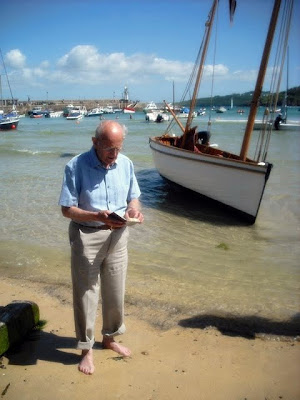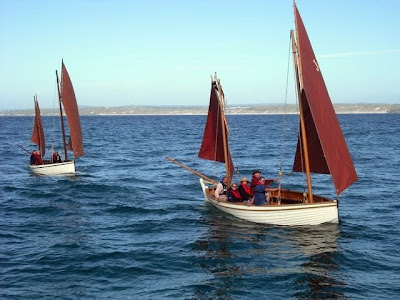
With police escort and lead by 'Piglet' - the town-crier borrowed from Penzance (how don't St.Ives have their own?), the new jumbo entered the town right at 10am sharp temporarily bringing traffic to a standstill.



By the time we launched her onto the sand to await the flood tide a large crowd had gathered for the naming ceremony lead by Matthew Care.

Next up, the winners of the jumbo painting competition receive their medals from the mayor.
We also received a blessing in Cornish from Mick Paynter, Grand Bard of the Cornish Gorseth and relative of the 19th cent. designer after whom she is named.
 As you can see, we were unbelieveably lucky with the weather. Early indications suggest William Paynter is every bit as fast as her sister.
As you can see, we were unbelieveably lucky with the weather. Early indications suggest William Paynter is every bit as fast as her sister.
The day concluded with the customary pint and shout with the Cadgwith Singers at the Castle. Strangely no pictures were available. (All these, incidentally, were taken by my brother Damian- over from the States
I'm really sorry if you were unable to make the occasion. But here they are waiting for your next visit!
With very best wishes to you all.
Jonny
all photos courtesy Jonny Nance
Jonny Nance and the St. Ives Jumbo Association launched the second Jumbo, the William Paynter, in June. Seems to have been a joyous affair with a large attendance. The two boats are now racing and also available for sails in St. Ives, Cornwall. Mr. Nance and the association are using these boats to promote civic involvement, awareness of tradition, and ultimately, a return to fishing under sail, which was the original purpose of these boats, and which evolved in response to local conditions.
Jonny first wrote about this two years ago on the St. Ives Jumbo page, and I'd like to share that original vision with you:
When sailing the Jumbo you can readily appreciate why the lug rig remained popular for small fishing boats through to the last days of sail. To start with you've a wonderfully clear working area with the masts out of the way, and no boom to duck under. Even when close-hauled the sail and sheets are clear of the work area. This, combined with he manageable scale of the boat and rig makes the Jumbo an ideal model on which to develop skills and explore the potential of fishing for a living - under sail.
Our aim is to establish a racing class of these boats at St.Ives in order to regenerate a waterfront community in decline. How much more effective it would be if, in addition, these boats could be eventually used for the purpose for which they were designed whilst providing a seasonal income for a couple of individuals!
Clearly, there may come a time when, in addition to any green, carbon neutral credentials, a sail-operated fishery could become commercially viable or at least a natural way of conserving resources (as demonstrated by the Falmouth oyster fishery -much celebrated as the last in the world to be worked under sail). In the meantime the skills required need to be developed.
There's a growing recognition that this approach would at least address some serious issues; the sustainability of fish stocks, the rising cost of fuel, the dependence on imported goods and the lack of employment opportunities in rural areas to name a few.
And if successful, the model could be readily repeated elsewhere.
Only a few months ago such a proposal would have been dismissed as romantic fantasy. So far however, my inquiries have been met with a degree of excitement .
Stephen Perham, the Harbour Master of Clovelly, who has been working the herring season there for decades, explained he has been thinking of reviving the 'picarooner' (their Jumbo equivalent) for the purpose. It's no coincidence that a replica of this particular craft is currently under construction by students on the Traditional Boatbuilding Course at Falmouth Marine School.
Nathan De Rozarieux, the Project Director of Seafood Cornwall reckons there's sufficient public awareness to support a significant premium for 'zero-carbon' fish when sold direct to the customer. This would ensure a market for the smallest catches. This view is shared by Matthew Stevens MD of Matthew Stevens and Son, the regions leading supplier of fish and seafood based in St.Ives,who said,
"Clearly the time is right for an initiative like this. We look forward to receiving their first catch!"
Even the authorities are supportive. The Marine Fisheries Agency at Newlyn inform me that obstructive legislation has been amended to allow unlicenced (unpowered) vessels of under 10m. to land and sell fish.
Without realising it individuals from each of the contributing sectors: boatbuilders, part-time fishermen, fishing authorities, and marketting have been quietly thinking along parallel lines but as yet have not joined forces.
We are on the threshold of a revival that could see several small, inshore and engineless fleets springing up around our shores over the next decade.
The logical place to start is where we left off - and engines took over.
Sceptical? Of course - but just think where the organic industry was only 30 years ago!
Also, found on the website today:
"2 years after Jonny Nance put out a press release promoting 'Fishing under sail' the idea is catching on...!
"Readers of Classic Boat have nominated our humble craft - almost unknown before we came along - 24th out of the top 50 classic boats. So there you are. It's official - she's a classic! William Paynter (her 19th cent. designer) would be chuffed!"
There has also been a design competition put forward by Classic Boat to design a boat for British fishing under sail, which was endorsed by the British Parliament. Unfortunately, the Classic Boat search function is down and I haven't been able to reference either results.
Jonny first wrote about this two years ago on the St. Ives Jumbo page, and I'd like to share that original vision with you:
When sailing the Jumbo you can readily appreciate why the lug rig remained popular for small fishing boats through to the last days of sail. To start with you've a wonderfully clear working area with the masts out of the way, and no boom to duck under. Even when close-hauled the sail and sheets are clear of the work area. This, combined with he manageable scale of the boat and rig makes the Jumbo an ideal model on which to develop skills and explore the potential of fishing for a living - under sail.
Our aim is to establish a racing class of these boats at St.Ives in order to regenerate a waterfront community in decline. How much more effective it would be if, in addition, these boats could be eventually used for the purpose for which they were designed whilst providing a seasonal income for a couple of individuals!
Clearly, there may come a time when, in addition to any green, carbon neutral credentials, a sail-operated fishery could become commercially viable or at least a natural way of conserving resources (as demonstrated by the Falmouth oyster fishery -much celebrated as the last in the world to be worked under sail). In the meantime the skills required need to be developed.
There's a growing recognition that this approach would at least address some serious issues; the sustainability of fish stocks, the rising cost of fuel, the dependence on imported goods and the lack of employment opportunities in rural areas to name a few.
And if successful, the model could be readily repeated elsewhere.
Only a few months ago such a proposal would have been dismissed as romantic fantasy. So far however, my inquiries have been met with a degree of excitement .
Stephen Perham, the Harbour Master of Clovelly, who has been working the herring season there for decades, explained he has been thinking of reviving the 'picarooner' (their Jumbo equivalent) for the purpose. It's no coincidence that a replica of this particular craft is currently under construction by students on the Traditional Boatbuilding Course at Falmouth Marine School.
Nathan De Rozarieux, the Project Director of Seafood Cornwall reckons there's sufficient public awareness to support a significant premium for 'zero-carbon' fish when sold direct to the customer. This would ensure a market for the smallest catches. This view is shared by Matthew Stevens MD of Matthew Stevens and Son, the regions leading supplier of fish and seafood based in St.Ives,who said,
"Clearly the time is right for an initiative like this. We look forward to receiving their first catch!"
Even the authorities are supportive. The Marine Fisheries Agency at Newlyn inform me that obstructive legislation has been amended to allow unlicenced (unpowered) vessels of under 10m. to land and sell fish.
Without realising it individuals from each of the contributing sectors: boatbuilders, part-time fishermen, fishing authorities, and marketting have been quietly thinking along parallel lines but as yet have not joined forces.
We are on the threshold of a revival that could see several small, inshore and engineless fleets springing up around our shores over the next decade.
The logical place to start is where we left off - and engines took over.
Sceptical? Of course - but just think where the organic industry was only 30 years ago!
Also, found on the website today:
"2 years after Jonny Nance put out a press release promoting 'Fishing under sail' the idea is catching on...!
"Readers of Classic Boat have nominated our humble craft - almost unknown before we came along - 24th out of the top 50 classic boats. So there you are. It's official - she's a classic! William Paynter (her 19th cent. designer) would be chuffed!"
There has also been a design competition put forward by Classic Boat to design a boat for British fishing under sail, which was endorsed by the British Parliament. Unfortunately, the Classic Boat search function is down and I haven't been able to reference either results.












































































